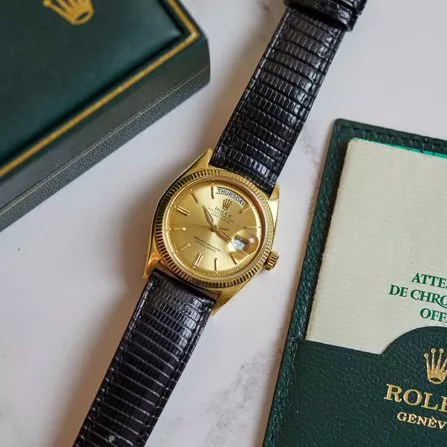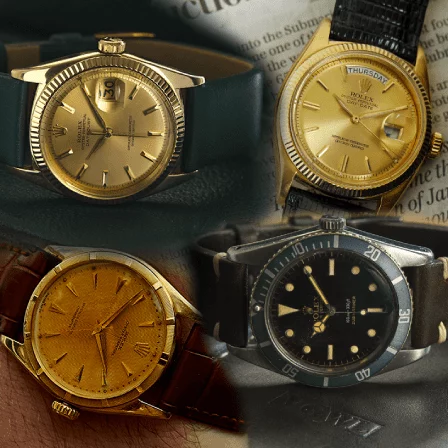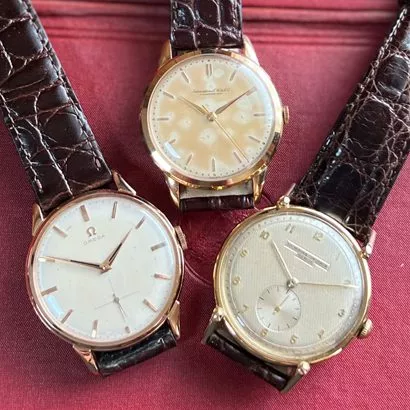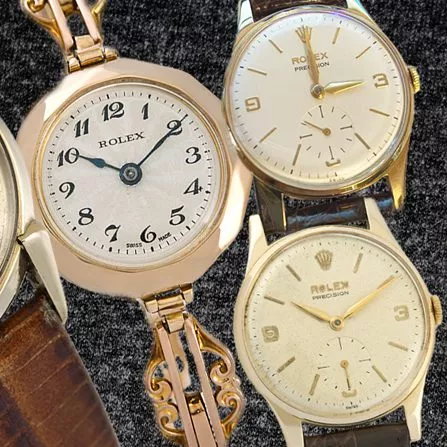HOW TO CLEAN YOUR
VINTAGE WATCH
Like anything valuable you want to maintain and keep in good condition, your vintage watch should be cleaned regularly to keep it in good condition and help preserve its value. Whether you wear your vintage watch regularly or for special occasions only, it still needs regular care and attention.
How often you should clean your watch is a matter of debate. If your vintage watch is worn daily, bear in mind the exposure to dirt, grime and pollution that it will suffer. Not to mention the oil and sweat that accumulates from being worn on a hard working part of the body regularly exposed to the elements.
This accumulation of grime not only affects how the watch looks but more importantly can damage the various sealants, O rings and finishing on both the watch and bracelet.
Hopefully, you have your watch professionally serviced (frequency depends on the manufacturer’s recommendations, usually every three to four years). As part of such servicing comes a thorough deep clean.
But assuming you don’t have your watch serviced every month, we recommend you learn how to clean your vintage watch at least this often, at home. When it’s so easy, quick and affordable, why wouldn’t you?
Here is our step-by-step guide to cleaning your vintage watch.

What You’ll Need
Prepare all the tools you will need before you start cleaning and ensure you know how to use them effectively. You will need:
1) A watch cleaning brush or a soft-bristled toothbrush
The brush needs to be as soft as possible – so a medium to hard toothbrush that has been used is fine. Alternatively, you can find watch cleaning brushes easily online at a reasonable price. Whichever type of brush you use, make sure it is dry before it goes anywhere near your watch. Damp is fine, but not dripping wet.
2) Toothpicks
You’ll need these to get into all the nooks and crannies where grime gathers. Make sure to use wooden or plastic toothpicks. Never be tempted to use anything metal or any hard tools that could damage the surface of the watch.
3) A clean microfibre cloth
Preferably unused, to guarantee no filament or grease is stuck on the surface of the cloth. Microfibre cloths can be bought on the high street, at supermarkets or opticians or easily found online.

4) Anti-bacterial sanitary wipes
Make sure you use sanitary wipes designed for use on the body rather than home cleaning wipes. Home cleaning wipes often contain bleach and other harsh chemicals that may damage your vintage watch. That’s why we also recommend using eco-friendly wipes that contain gentle cleaning agents.
Optional extras:
5) Spring bar tool
This is the only specific piece of kit needed for thorough cleaning. It allows you to remove the watch strap by taking out the spring bar from between the lugs. Spring bar tools usually come as part of a watch cleaning kit. Alternatively, you can find them online or ask your vintage watch dealer.
6) Watch care kits
Depending on your vintage watch dealer, you may have received a watch care kit with your vintage watch purchase, as do the customers at Vintage Gold Watches. You canbuy a watch care kit in the Accessories section of our online shop.
The Vintage Gold Watches Care Kit Contains:
Gold Polishing Cloth – The cloth is impregnated with a mildly abrasive solvent which is specially formulated for polishing gold watches and jewellery. This will not harm your watch case in any way. It is most useful for removing any tarnishing which builds up on the case over time and will also help to remove very fine scratches, although this may take some time. Gently rub all the surfaces and around the lugs to bring the watch case back to its bright and shiny condition. Depending on how often you wear your watch, you might wish to do this every 3 – 6 months.
Small Chamois Leather – For removing any residue and fingerprints from the watch case, following cleaning with the Polishing Cloth.
Tube of Polywatch – This is for use in case your acrylic watch lens becomes scratched, marked, or simply becomes dull. Place 4 – 6 drops on the watch lens and rub this with your forefinger with some gentle pressure. If you prefer you may use a piece of cotton wool with a few drops also added to the cotton wool. Depending on the state of the lens you should rub the lens for around 5 minutes, before removing the residue with a clean piece of cotton wool. It works like magic!
Bottle of Watch Strap Conditioning Oil – This will help to maintain the life and appearance of your watch strap. First, if your strap has become dirty, clean it as per the strap cleaning instructions below. Take your time as it is best to only apply the very slightest amount of the oil, and apply more later if needed. To do this, place two or three drops of oil on the tips of your fingers and rub the oil between your fingers and thumb. Then gradually rub both sides of the strap, all over, with your fingers and thumb. If you feel the strap will take a little more oil, repeat the process. Then wipe the strap with a clean dry cloth. Depending on how often you wear your watch, you might wish to do this every 6 – 12 months.

Important Points Before You Get Started
Before you get carried away with any overzealous cleaning, it’s important to highlight some things that you should refrain from doing to avoid any mishaps;
1) Ensure everything is completely clean – including your hands and the area where you will be cleaning the watch.
2) Never use hard tools such as screwdrivers or tweezers to remove stubborn grime. This is particularly important when cleaning gold, titanium or bronze watches. These are softer metals and can be damaged or scratched easily. Don’t take any chances.
3) Don’t use ultrasonic cleaners. You may have seen them used on other pieces of jewellery but never use them on your watch.
4) Never fully submerge your watch face into water or run it under a tap. Some can be treated in this manner but it’s best to avoid it if you can. Water resistance can be lost with age, and a badly attached crown could also let water inside and destroy the watch. As you will be using damp cloths in the cleaning process, ensure that all screws and crowns are tightened to avoid any water damage.
5) Don’t clean over a hard surface. Use a protective mat, or layer up a clean towel, and clean the watch over that. Just in case things become fiddly and you drop it.
6) Be sure you know the material of both the watch itself and its strap. This will affect the cleaning method.
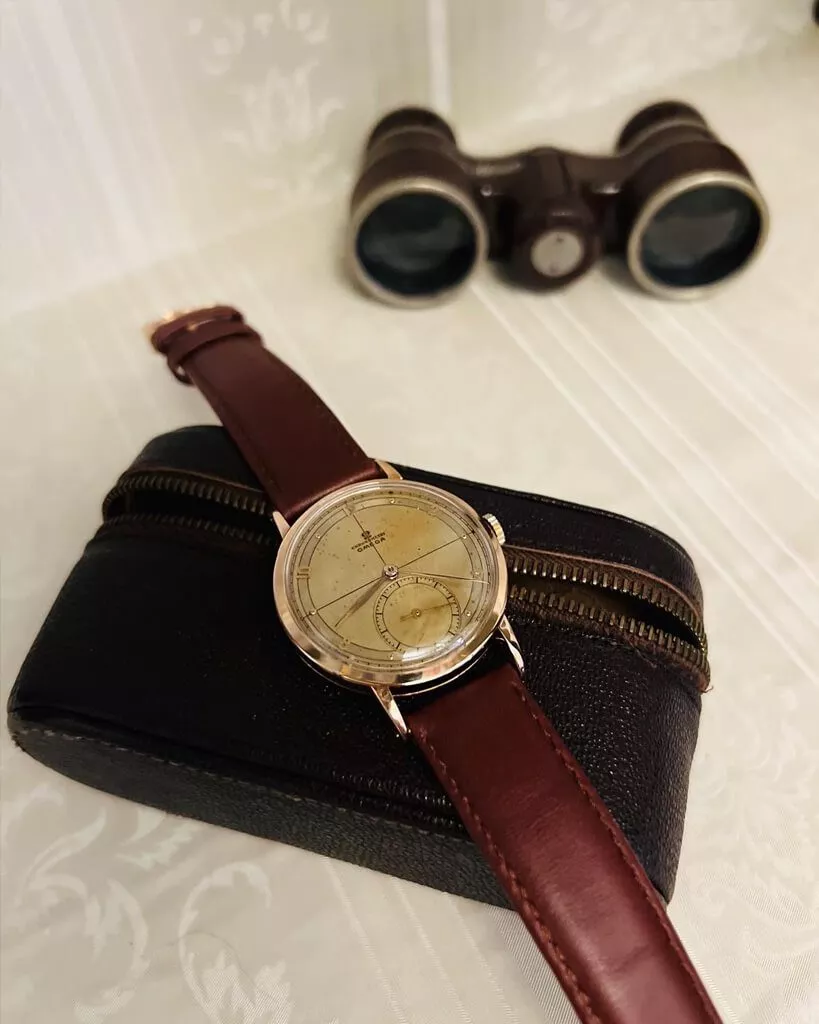
Inspect the Watch
When you have everything ready and clean you can get to work. Use this time to inspect your watch carefully. Ensure you have enough direct light to work so you can see all the fine details. A magnifying glass could be useful here.
Check that the clasps are working properly and check for any scratches or damage as you go. Pay particular attention to the condition of the crown, or other moving parts.
Likewise, look at the edge of the crystal (where it is mounted to the case). If your crystal has a chip or even a visible area where it is not firmly connected to the case, your watch needs to be professionally inspected and serviced before it is cleaned.
If servicing or repairs are needed be sure to work with a reputable vintage watch technician with experience in such skilled work, such as Vintage Gold Watches in London. We have the expertise and experience to fully clean, service, restore and repair vintage watches.

Remove the Strap or Bracelet From Your Watch
If you are comfortable doing so, you can remove the strap or bracelet from the watch. You can do so using a spring bar tool to gently prise open the spring bar from under the lugs. It can be tricky sometimes but achievable. If you have a leather or textile strap it is advisable to remove it, as it will require a separate cleaning method.
If you have a metal bracelet you can leave this on if you prefer, although ideally, we recommend removing the bracelet so you can clean thoroughly around the lugs and where the strap attaches to the case.
Do not take the watch apart in any way. Doing so can damage the O-rings, expose the inner workings to humidity, or worse. Leave the deep, internal cleaning to the experts.
Clean the Watch Strap or Bracelet
Bracelets tend to accumulate the most grime as the dirt stacks up in between the links and clasps. How you clean the strap or bracelet depends on its material. Here are some different methods we recommend for different strap or bracelet types:
- Leather
Wipe down the leather with a damp cloth. If it’s really dirty, you can use a very small amount of hand soap on the cloth in addition to water. Fully dry it with a clean, dry cloth and use a small amount of conditioning oil before reattaching it to the watch. The conditioning oil helps to prevent the leather from cracking due to exposure to the elements.
- Metal
Metal watch bands are prone to rusting so clean them with soapy water and a bristle brush, carefully but thoroughly cleaning in between the links and clasp mechanism. Allow it to fully air dry.
- Nylon
These are the easiest to clean. Put it in a mesh laundry bag (or a pillow case) and put it in the washing machine – job done.
- Rubber
Rubber or silicone is similar to metal in that it attracts and absorbs oil. Clean the strap exactly the same way you would do a metal strap; using soapy water and a bristle brush. Rinse with cold water when finished and allow it to fully air dry. Once fully dried, apply a rubber protector spray to keep it in tip-top condition.

Wipe the Watch Face
Using the antibacterial wipes, gently clean the surface of the watch face. Avoid applying too much pressure or rubbing vigorously as you are only interested in collecting the loose dirt and debris that has attached to the face.
If there are stubborn marks, use a cotton earbud dipped into a small amount of soapy water and gently work around the watch face. Remember to use a minimal amount of water – the earbud should be damp not soaking wet – this is critical to avoid water finding its way in between old brittle o-rings or casings that are not completely sealed.
Many older watches will have grease or fingerprints on the watch face. A gentle rub with a dry pencil eraser will remove this without damaging the glass or metal. Alternatively, the Polywatch product mentioned above in the ‘What You’ll Need’ section is also a great product for this task.

Using the Toothpick
You can use the toothpick on any part of the watch or bracelet where dirt has built up in hard-to-reach nooks and crannies.
To be certain that you don’t cause damage in the process, prepare the toothpick in the following way: Take a toothpick and cut off the sharp pointy end. Now wrap it in a sanitary wipe, doubling it up if you want to ensure the toothpick doesn’t poke through the wipe whilst you’re working.
Soft metals can be scratched even by a toothpick, so be careful. Use the blunted end to gently nudge off any dirt and wipe it away with the sanitary wipe. The bristle brush is also helpful for brushing away any debris that you have loosened off.

Dry and Polish with a Microfibre Cloth
Finish the cleaning process by using a microfibre cloth to gently wipe over all surfaces to absorb any excess moisture and oil left from your hands. Make sure you work the cloth into every nook and cranny, like the lugs and the case back seam.
You can reattach the strap or bracelet once it’s completely dry. We recommend leaving straps to air dry fully. It’s best to leave it in a cool dry place, out of direct sunlight, for 24 hours before securing it to the watch.
A Note on Servicing
As you can see it is not a particularly difficult or laborious process, but it does require care and attention. Even so, if you have any doubts about your ability to clean your vintage watch or the materials it is made of, do not risk damaging it. Take it to a reputable vintage watch technician who will lovingly and expertly deep clean it for you.
To ensure the longevity and integrity of your valuable vintage timepiece, it is essential to have it serviced periodically by a professional who is knowledgeable and experienced with vintage watches.
At Vintage Gold Watches, our experienced watchmakers provide a full range of services that cater specifically to vintage watches, including professional servicing, repairs and restoration. For full details about restoration services view here. Get in touch with us if you have any questions, we are happy to help.
To keep up to date on vintage watch news, sign up to our regular newsletter.

